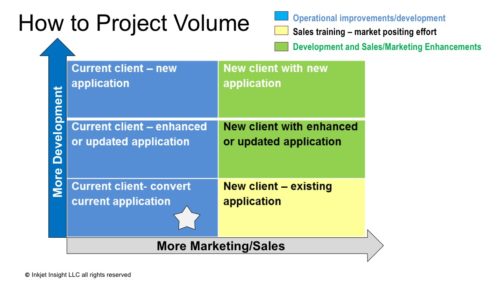This week Elizabeth Gooding was the keynote speaker and panel moderator at a thought leadership workshop hosted by Xerox at its Gil Hatch Center for Customer Innovation. Xerox assembled a group of printing executives from transactional, book, inplant, and commercial printing to explore production inkjet opportunities. This article summarizes key points from the keynote.
Getting to the Why
There are logical reasons that drive most buying decisions and that’s true for production inkjet, but the “why” is different every organization. In the B2B market it usually comes down to a balance of 3 core drivers:
- You need to do it faster.
- You need to do it cheaper.
- You need to do more of it (and grow business).
That last one is tricky and one to keep in mind.
The Why for Transactional Printing
Transaction printers have an operational imperative driven by postal expenses and creating a white-paper environment. Simple forms replacement is often enough to make the business case for color inkjet before even considering the revenue enhancement opportunities. Adding MICR for checks and coupons to the mix drives can drive operational efficiencies across many vertical markets. However, MICR use is declining so look carefully at whether you need this in the inkjet device or not.
The Why for Direct Marketing
Direct marketing benefits greatly from eliminating pre-printed shells. There is time sensitivity for all aspects of the campaign execution: the mailing, the volume, and the level of personalization. Direct mailers have the potential for new revenue driven from the availability of 100% personalized mail pieces. High speed and full color present many opportunities for high volume data-driven direct mail and also great opportunities to replace smaller web versions of color jobs using inkjet.
The Why for Books
The book market is trying to make effective use of equipment in a chaotic market with a price sensitive supply chain. Flexible workflow and the ability to print very crisp black text are key in this market, as well as the need to respond to changes in content publishing. Smaller production runs and “books of one” have become common customer requirements.
The Why for In-Plant Operations
In-plant operations are like burritos — you never really know what’s wrapped up in there. In-plant operations come in all shapes and sizes. You could be talking about the copy shop in a small insurance organization, transaction printing at a major bank, a multi-purpose in-plant for a college or school system. In-plant have cross-segment requirements, they have internal pricing pressures driven by outsourcing initiatives, require flexibility in applications and media, be responsive to internal requests, and add value to the organization.
What’s Your Why? If you don’t understand your “Why” you will really struggle with the How.
If you are going to invest in an inkjet solution– you need it to get up and running fast and you need to keep it running – which means you have to have the volume ready to go when you are ready to flip the switch. Your target volume is one of the most important metrics in making the business case for inkjet. This takes solid analysis and planning.
It’s easiest if you have a large existing client that can transition over by just replacing the form with preprinted stock, but usually there is some enhancement to be done with this type of transition. If you are going to make enhancements to an existing application then you want to ask yourself if there are opportunities to make it repeatable for other clients in other markets.
This approach may require additional investment and development but it also opens up a lot of opportunity and future sales. Be sure to have sales and marketing involved early on when making these types of changes and enhancements. They are your best asset in understanding the potential for repurposing a workflow or application production process.

The bottom line is that if you can generate enough volume from the lower left side of the chart – you have a much shorter path to profitability than if you need to generate the volume from the upper right part of this chart – new clients and new applications.
However, if inkjet provides new opportunities to do new things and generate more business, you will need to factor that into the plan too.

Comments
This article is really informative. I’m currently working on a document to explain the “Why” for our DuraLink Digital Inkjet Technology.
Do you have any insight for the “Why” for digital inkjet for Package Printing or Flexible Packaging?
Hi Tina – that sounds like a great topic for another post. Let’s talk.